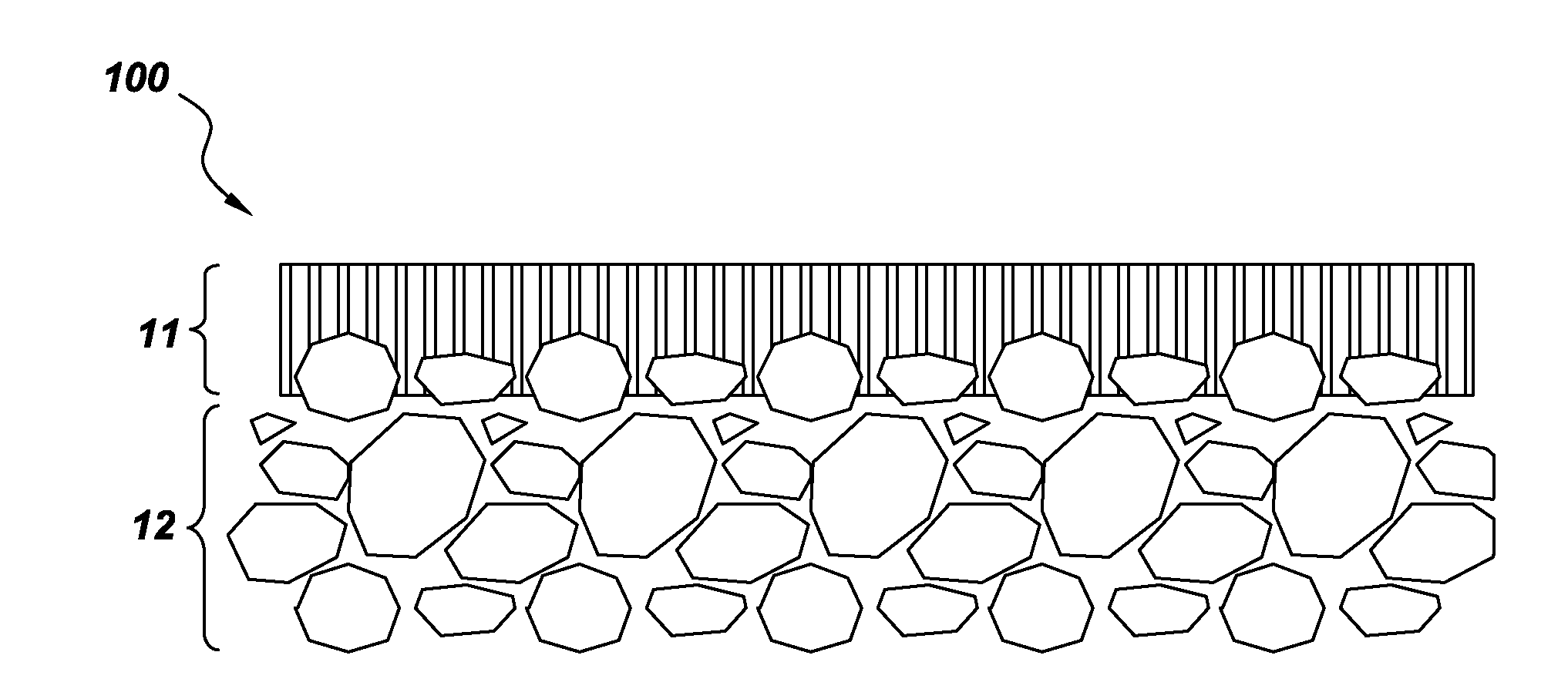Membranes for separation of carbon dioxide
- Summary
- Abstract
- Description
- Claims
- Application Information
AI Technical Summary
Benefits of technology
Problems solved by technology
Method used
Image
Examples
example 1
Membranes Prepared from Sol with Porogen and Low Fractal Dimension
[0031]A sol was prepared by combining a solution containing tetrapropylammonium bromide (TPABr), water (H2O), nitric acid (HNO3), and isopropanol (IPA) in the molar ratio: 1:185:1.5:740, and a solution containing titanium isopropoxide (TIIP) in isopropanol (IPA) in the molar ratio: 1:7.2. The first solution was added dropwise to the second solution under vigorous stirring over a five minute period to produce a solution with molar composition: 1 TPABr:185H2O:1.5 HNO3: 103 TIIP:1500 IPA. In a typical experiment, each solution was prepared on a 10 g IPA basis and combined to produce a solution with 20 g total IPA.
[0032]The resulting sol was filtered to remove dust and other particulates, aged for an additional two to twenty minutes, and diluted in isopropanol at a rate of 1 g sol to 1.5 g isopropanol. Dynamic light scattering measurements indicated the nominal particle size was between 3 and 6 nm. Small angle x-ray scatt...
example 2
Membranes Prepared from Sol with High Fractal Dimension without Porogen; No Intermediate Layer Film
[0037]The samples were prepared as above, with the following changes: no TPABr was used in the first solution, the solution was aged for over 90% of the gel time, and aging time was 2 to 20 days. The solution was then diluted at a rate of 1 g sol to 10 or 20 g IPA.
[0038]A two coat membrane was prepared on a substrate with no alumina intermediate layer. The substrate was composed of a thick layer (>50 um) of alumina with large pores in the nominal size range of 10 to 40 nm. The resulting membranes typically had the following structure:
TiO2 layer, thickness 50-500 nm, pore size 2 over nanocrystalline TiO2.)
Al2O3 support layer, thickness 200 nm, pore size ˜20 nm
[0039]The best membrane prepared under these conditions had a room temperature CO2 / H2 selectivity of 2.0. Upon heating this declined to 0.41 at 250° C., which is about 2.0 times the value expected for Knudsen selectivity. The sampl...
example 3
Baselines and Benchmarks
[0040]FIG. 3 shows the CO2 transport through a supported silica membrane, a supported titania membrane, and an uncoated support for an equimolar CO2—H2 gas mixture. Both membranes showed a reduction in CO2 permeance of almost an order of magnitude relative to the support confirming that the deposited film controls gas transport through the membrane. However, the temperature trends indicated drastically different mechanisms for CO2 transport. The CO2 permeance through the bare support decreased with increasing temperature, as expected for Knudsen flow. The ratio of permeances at 250° C. and 50° C. is 0.77, which agreed with the expected ratio of 0.79 for Knudsen behavior. The CO2 permeance through the silica membrane also decreased with temperature, but at a higher rate than through the bare support. At low temperatures, a large portion of the CO2 transport through silica at was due to surface transport. The weakening of this mechanism at higher temperatures e...
PUM
 Login to View More
Login to View More Abstract
Description
Claims
Application Information
 Login to View More
Login to View More - R&D
- Intellectual Property
- Life Sciences
- Materials
- Tech Scout
- Unparalleled Data Quality
- Higher Quality Content
- 60% Fewer Hallucinations
Browse by: Latest US Patents, China's latest patents, Technical Efficacy Thesaurus, Application Domain, Technology Topic, Popular Technical Reports.
© 2025 PatSnap. All rights reserved.Legal|Privacy policy|Modern Slavery Act Transparency Statement|Sitemap|About US| Contact US: help@patsnap.com



